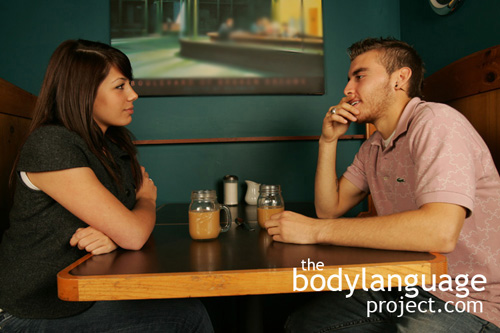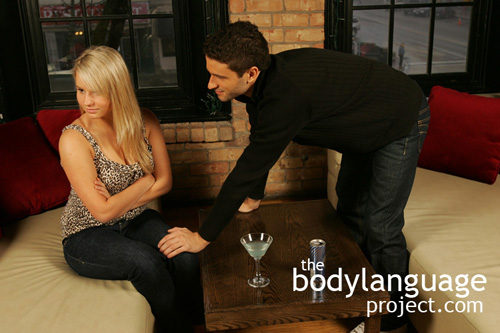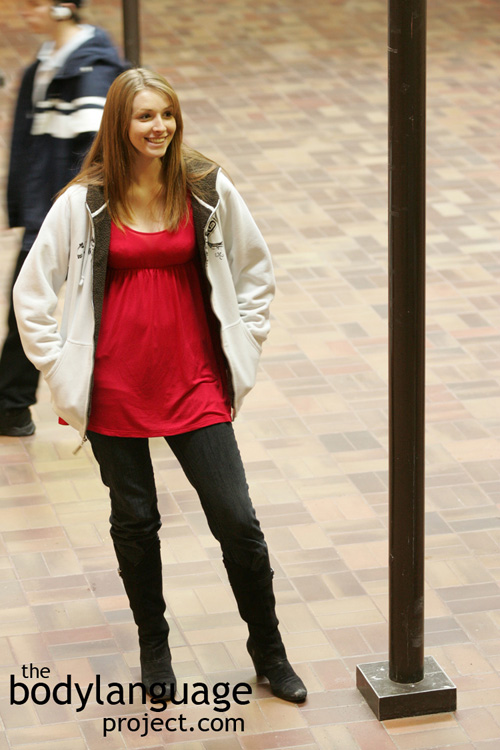Body Language of Encroaching
Synonym(s): Space Invader, Close Talker (The), Moving In Too Close, Invading Space.
Description: When one person approaches someone else too closely and invades their personal space.
In One Sentence: Encroaching on other people’s space is a sign that a person wishes to increase intimacy or to intimidate.
How To Use it: Encroaching on others spaces can be used in order to build intimacy or to intimidate.
In a dating context, encroaching can be a way to test tolerance to space intimacy. Men can approach women and thereby test their reaction. If a woman recoils in the face of an advance, it’s a sign that she is not interested or prepared for romantic involvement. On the other hand, if she tolerates an invasion of space, the reverse is true. Women can also encroach on a man’s space to test his interest and even test him romantically.
Invading space in dating can also be done with the use of inanimate objects. Lending a jacket to a girl is a way men can move his property into her territory. Acceptance of this intrusion is a signal that interest and trust is developing.
Out of a dating context, men can use encroaching to invade the territory of other men. Usually more submissive men will tolerate the advancements of alpha or dominant men. Men can also use closeness on other men in a more fleeting way to build friendships, but rarely tolerate persistent encroachment. When men wish to bond to other men, therefore, it’s best use in handshakes, pats on the back, and when deep friendships form, hugs.
When encroaching is done to the extreme however, people usually see this as overbearing and a sign of social awkwardness.
Women can use encroachment on other women, as it tends to be more mutually accepted and a way for them to create social bonds.
Context: a) General b) Dating.
Verbal Translation: a) “I’m going to move closer to you so you feel awkward and heed to my power and dominance.” a) “Because I lack social skills I’m approaching you too closely.” b) “I’m feeling your attraction so I’m being drawn into your personal space.”
Variant: See Leaning In and Leaning Out, Becoming Loud, Touching or Increase In Touching.
Cue In Action: a) In an attempt to gain affection, Dave snuggled up to Mary. She was taken aback as she thought of him more as a friend than a lover. She leaned back awkwardly. b) The boss typically pulled people in after shaking hands with them. He was a tall man and used his height advantage to intimidate others.
Meaning and/or Motivation: Encroaching involves standing too close, standing over someone by exploiting height differences, touching when un-welcomed, and even raising voices or the volume of music to violate the privacy and comfort of others.
Encroaching is any body language that takes advantage of proxemics to violate a person’s personal space and territory and create defensive body language in others. When someone encroaches it usually indicates a power play to assert dominance and authority.
Other times it is due to inappropriate socialization, such that a person doesn’t understand the social norms and requirements of other people. People from highly populated areas typically require less personal space than those who live in sparsely populated areas. When city people and country people come together there may differences in personal space requirements causing issues. The person from the city might move in close to create connectivity forcing the country person to step backwards. The person from the city feels rejected and the person from the country feels violated.
Getting close to someone else might also spell romantic interest. When women or men wish to send a strong signal, they will approach each other and enter their respective personal space zones in effort to build intimacy.
Cue Cluster: The cue clusters by which encroachment presents itself will be related to the intent of encroachment as well as the feelings surrounding it. When encroaching, a person will lean in, their head will move forward and their toes will point and extend toward. When being encroached upon, a person will lean out, their head will move back, their toes and torsos will point away and their feet will move back. The context will decide the intent of the message, be it sexual in nature or a power play.
Body Language Category: Arrogance or arrogant body language, Aggressive body language, Distancing or moving away, Dominant body language, Escape movements, Hostile body language or hostility or anger, Negative body language, Threat displays.
Resources:
Aranguren, Martin. “Nonverbal interaction patterns in the Delhi Metro: interrogative looks and play-faces in the management of interpersonal distance.” Interaction Studies. 2016. 16(1) forthcoming.
Aranguren, Martin and Stephane Tonnelat. Emotional Transactions in the Paris Subway: Combining Naturalistic Videotaping, Objective Facial Coding and Sequential Analysis in the Study of Nonverbal Emotional Behavior. Journal of Nonverbal Behavior. 2014. 38:495–521. DOI 10.1007/s10919-014-0193-1
http://bodylanguageproject.com/articles/seriously-stop-touching-use-nonverbal-signaling-manage-unwanted-touching-busy-public-areas
Anderson, C. A., & Bushman, B. J. (2002). Human aggression. Annual Review of Psychology, 53, 27–51. http://dx.doi.org/10.1146/annurev.psych.53.100901. 135231.
Argyle, M., & Dean, I. Eye contact, distance and affiliation. Sociometry, 1965, 28, 289-304.
Boucher, Michael L. Holzberg, Jules D. (editor). Effect of seating distance on interpersonal attraction in an interview situation. Journal of Consulting and Clinical Psychology. 1972 38(1): 15-19.
Beaulieu, Catherine. Intercultural Study of Personal Space: A Case Study. Journal of Applied Social Psychology. 2004 34(4):794-805.
Cook, M. Experiments on orientation and proxemics. Human Relations, 1970, 23, 61-67.
Coutts, Larrym. ; Ledden, Maribeth. Nonverbal Compensatory Reactions to Changes in Interpersonal Proximity. The Journal of Social Psychology. 1977 102(2): 283-290.
Céline Jacob and Nicolas Guéguen. The Effect of Physical Distance Between Patrons and Servers on Tipping. Journal of Hospitality & Tourism Research 2012. 36: 25 originally published online 15 November 2010. DOI: 10.1177/1096348010388660g
http://bodylanguageproject.com/articles/heres-a-tip-dont-stand-too-far-away/
Cook, Mark. 1970. Experiments on orientation and proxemics. Human Relations 23 (1): 61-76.
Derlega, Valerian ; Lewis, Robin ; Harrison, Scott ; Winstead, Barbara ; Costanza, Robert. Gender differences in the initiation and attribution of tactile intimacy. Journal of Nonverbal Behavior. 1989. 13(2): 83-96.
Derlega, Valerian J. ; Catanzaro, Diane ; Lewis, Robin J. Lisak, David (editor). Perceptions About Tactile Intimacy in Same-Sex and Opposite-Sex Pairs Based on Research Participants’ Sexual Orientation. Psychology of Men & Masculinity, 2001, Vol.2(2), pp.124-132
Dolphin, Carol Zinner. Beyond hall: Variables in the use of personal space in intercultural transactions. Howard Journal of Communications. 1988. 1(1): 23-38.
Felipe, N. Interpersonal distance and small group interaction. Cornell Journal of Social Relations, 1966, 1, 59-64.
Girard, Jeffrey M.; Jeffrey F. Cohna; Mohammad H.Mahoor S.; Mohammad Mavadati;
Zakia Hammal; and Dean P. Rosenwalda. Nonverbal Social Withdrawal In Depression: Evidence From Manual And Automatic Analyses. Image and Vision Computing. 2013.
http://bodylanguageproject.com/articles/body-language-signals-withdrawal-depression/
Gulledge, Andrew K ; Stahmann, Robert F ; Wilson, Colwick M. Seven types of nonsexual romantic physical affection among Brigham young university students
Psychological reports 2004, Vol.95(2), pp.609-14
Gulledge, Andrewk. ; Gulledge, Michelleh. ; Stahmannn, Robertf. Romantic Physical Affection Types and Relationship Satisfaction. The American Journal of Family Therapy, 2003, Vol.31(4), p.233-242
Greenberg, Carl I. ; Firestone, Ira J. Greenwald, Anthony G. (editor). Compensatory responses to crowding: Effects of personal space intrusion and privacy reduction. Journal of Personality and Social Psychology. 1977. 35(9): 637-644.
Graziano, Michael S.A. and Cooke, Dylan F. Parieto-frontal interactions, personal space, and defensive behavior. Neuropsychologia. 2006. 44(6): 845-859.
Gifford, Robert ; O’Connor, Brian. Nonverbal intimacy: Clarifying the role of seating distance and orientation. Journal of Nonverbal Behavior. 1986 10(4): 207-214.
Gardin, Hershel ; Kaplan, Kalman J. ; Firestone, Ira J. ; Cowan, Gloria A. Lanzetta, John T. (editor). Proxemic effects on cooperation, attitude, and approach-avoidance in a Prisoner’s Dilemma game. Journal of Personality and Social Psychology. 1973. 27(1): 13-18.
Holt, Daphne J ; Cassidy, Brittany S ; Yue, Xiaomin ; Rauch, Scott L ; Boeke, Emily A ; Nasr, Shahin ; Tootell, Roger B H ; Coombs, Garth. Neural correlates of personal space intrusion. The Journal of neuroscience : the official journal of the Society for Neuroscience. 2014. 34(12): 4123-34.
Hadi, Rhonda ; Valenzuela, Ana. A meaningful embrace: Contingent effects of embodied cues of affection. Journal of Consumer Psychology, 2014, Vol.24(4), pp.520-532
Haase, Richard F. ; Dimattia, Dominic J. Berdie, Ralph F. (editor). Proxemic behavior: Counselor, administrator, and client preference for seating arrangement in dyadic interaction. Journal of Counseling Psychology. 1970 17(4): 319-325.
Johnson, Richard R. and Jasmine L. Aaron. Adults’ Beliefs Regarding Nonverbal Cues Predictive of Violence. Criminal Justice and Behavior. 2013. 40 (8): 881-894. DOI: 10.1177/0093854813475347.
http://bodylanguageproject.com/articles/wanna-fight-nonverbal-cues-believed-indicate-violence/
Kenner, Andrew N. ; Katsimaglis, George. Gender differences in proxemics: taxi-seat choice. Psychological Reports. 1993 72(2): 625(2).
Linz, Daniel ; Blumenthal, Eva ; Donnerstein, Edward ; Kunkel, Dale ; Shafer, Bradley J. ; Lichtenstein, Allen Wiener, Richard L. (editor). Testing Legal Assumptions Regarding the Effects of Dancer Nudity and Proximity to Patron on Erotic Expression. Law and Human Behavior. 2000. 24(5): 507-533.
Moore, Monica. Courtship Signaling and Adolescents: Girls Just Wanna Have Fun. Journal of Sex Research. 1995. 32(4): 319-328.
http://bodylanguageproject.com/articles/girls-just-want-to-have-fun-the-origins-of-courtship-cues-in-girls-and-women/
Mcelroy, James C. ; Morrow, Paula C. Personal space, personal appearance, and personal selling. Psychological Reports. 1994 74(2): 425(2).
Mcgurk, Barry J. ; Davis, John D. ; Grehan, John. Assaultive behavior personality and personal space. Aggressive Behavior. 1981. 7(4): 317-324.
Navarro, Joe. 2008. What Every BODY is Saying: An Ex-FBI Agent’s Guide to Speed-Reading People. William Morrow Paperbacks.
Newman, Robert C. ; Pollack, Donald Holzberg, Jules D. (editor). Proxemics in deviant adolescents. Journal of Consulting and Clinical Psychology. 1973 40(1): 6-8.
Olson, Loreenn. ; Braithwaite, Dawno. If you hit me again, I’ll hit you back:” Conflict management strategies of individuals experiencing aggression during conflicts. Communication Studies. 2004 55(2): 271-285.
Okken, Vanessa ; Van Rompay, Thomas ; Pruyn, Ad. Room to Move. Environment and Behavior. 2013. 45(6): 737-760.
Okken, Vanessa ; Van Rompay, Thomas ; Pruyn, Ad. Room to Move: On Spatial Constraints and Self-Disclosure During Intimate Conversations. Environment and Behavior. 2013. 45(6): 737-760.
Pailing, Andrea ; Boon, Julian ; Egan, Vincent. Personality, the Dark Triad and violence Personality and Individual Differences. 2014. 67: 81-86.
Remland, M. S. and T. S. Jones 1995. Interpersonal Distance, Body Orientation, and Touch: Effects of Culture, Gender, and Age. Journal of Social Psychology 135(3): 281-297.
Scherer, S. E., & Schiff, M. R. Perceived intimacy, physical distance, and eye contact. Perceptual and Motor Skills, 1973, 36, 835-841.
Scott, J. A. Comfort and seating distance in living rooms: The relationship of interactants and topic of conversation. Environment and Behavior, 1984, 16, 35-54.
Sommer, R. Studies in personal space. Sociometry, 1959, 22,247-260.
Sommer, R. The distance for comfortable conversation: A further study. Sociometry, 1962, 25, 111-116.
Sommer, R. Personal space: The behavioral basis of design. Englewood Cliffs, New Jersey: Prentice Hall. 1969.
Thomsen, Lotte; Willem E. Frankenhuis; McCaila Ingold-Smith and Susan Carey. Big and Mighty: Preverbal Infants Mentally Represent Social Dominance. Science. 2011. 331: 477. DOI: 10.1126/science.1199198
http://bodylanguageproject.com/articles/big-might-size-may-hardwired-dominance-study
Werner, Carol ; Brown, Barbara ; Damron, Gary Steiner, Ivan D. (editor). Territorial marking in a game arcade. Journal of Personality and Social Psychology. 1981. 41(6): 1094-1104.
Weiss, M., & Keys, C. The influence of proxemic variables on dyadic interaction between peers. Paper presented at the meeting of the American Psychological Association; Chicago, 1975, August.






